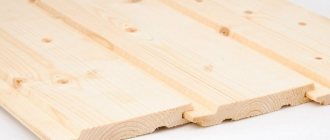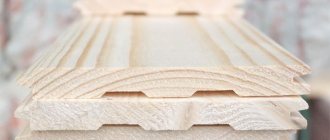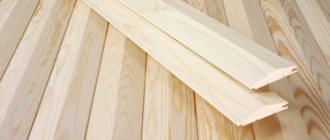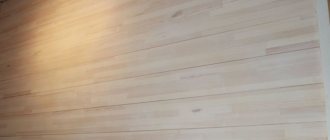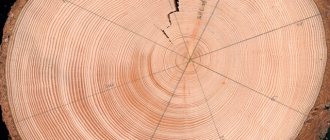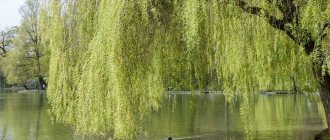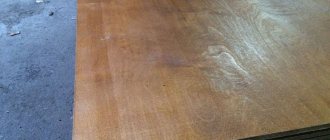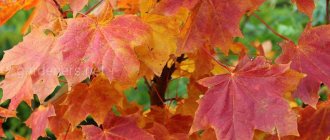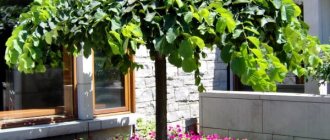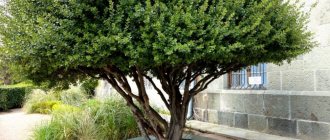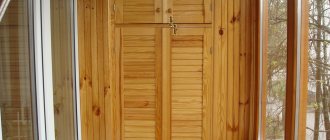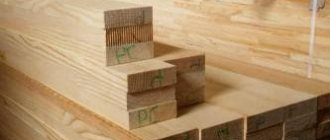Any building material has its own varieties. Quality depends on many factors, including density, resistance to damage, durability, etc. For wood products, this list is noticeably expanded, because the heterogeneity of the wood, the characteristics of the variety, and problematic processing significantly affect the method and ease of processing. Lining grades are used for quick classification of materials. Knowing the features of each of them, you can quickly select the optimal building material for a specific task and save a lot of money at the same time.
The variety is determined by a special employee of the technical department at the production stage. By performing a series of tests, this person sorts the finished products into 4 categories, which will later go on sale.
Type of lining: definition
The passport for a wooden product contains several key parameters on which the scope of application of the material depends:
- Material of manufacture;
- Lock type;
- Dimensions;
- Types of lining.
The material used is the type of wood used for sawing. The natural color and general physical characteristics (strength, reliability, possibility of use in rooms with a special microclimate) depend on it.
The type of lock indicates the peculiarity of the fastener and the ability to combine this finishing material with others. This parameter may not be indicated in the passport. Birch and linden boards with the same lock and sheet thickness can be used alternately to decorate the wall - this is acceptable for a number of projects. Also, the type of lock affects the appearance of the plane: the distance between the “shores” of the depressions between the board. “Calm” slats, for example, allow you to create a completely flat plane thanks to a hidden lock and butt-to-butt fastening.
Dimensions - the overall dimensions of the product. The length, width, and thickness of the sheet are indicated in millimeters. Example 150x15x2000 - respectively, width, thickness, total length of the lamella.
Type of lining - what does it mean? Let's start with the fact that the variety is determined based on the characteristics already indicated.
The key factors for determining are the type of wood, dimensions, quality of cut, natural characteristics of the sheet: the presence of knots, cracks, chips, etc.
No. 7. Is it possible to distinguish low-quality lining?
You should not always blindly trust the class indicated on the packaging - it is better to inspect the material with your own eyes . First of all, you should pay attention to the packaging. It is undesirable to use stretch film, since such storage negatively affects the moisture content of the lining. Of course, it is better to inspect the product before purchasing, but if the material is packed in film, then you will not be able to examine it, and they are unlikely to be allowed to open the packaging. The only way out is to purchase one or two packages and check the quality. If everything is fine with the lining, then the products already purchased will be useful, and if not, then you will insure yourself against larger financial losses.
The geometry of the product should not be violated - the lining lamella should be even. Even a small arc indicates that the material was stored incorrectly, and if such a board can be installed, it is unlikely to last long and will most likely soon come out of the lock. You also need to see the castle. There should be no knots or cracks on it, but it is better to take a clamp with you and check the reliability of the future connection. At specialized points there should be a tool that measures the moisture content of the lining, so you should not refuse the opportunity to check the real indicator. It should not exceed 15%.
Features of different types of wooden lining
Wooden lining is divided into 4 large subtypes. They may have different names, but the essence remains the same: from the worst to the almost ideal:
- C or 3rd;
- B or 2nd;
- A or 1st “Premium”;
- "Extra".
It is also worth noting that not only the appearance and ease of installation, but also the features of operation, the possibility of installation in rooms with a unique microclimate, the subtleties of processing, and further care depend on the variety. A detailed review should start from the most preferable to the downright bad.
Installation Features
One of the main positive qualities of lining is its simple installation. Typically, the tongue-and-groove method is used for fastening. The instructions for assembling and installing the lining are simple and accessible; anyone can cope with this task.
Installation of lining
A wide range of applications is an additional advantage to the other positive qualities of the lining. By laying the canvas horizontally, you can sheathe the outside of the house, laying the boards from bottom to top. It is advisable to install the boards one on top of the other, sealing the joints with mastic, which will provide thermal, sound and even hydro insulation.
When finishing the premises inside, you can lay the lining in various ways - vertically, horizontally and even obliquely. However, for example, in a bathhouse, vertical masonry is desirable, this will avoid the accumulation of water in the grooves.
To ensure ventilation, openings should be left from the floor and ceiling. Sometimes, in order not to allow excess moisture to pass through, about 30 cm above the floor are not covered with sheathing at all.
To begin laying the lining, you can first study the photos and videos presented on our website.
Extra grade lining
These are almost perfect sheets of medium-density wood. It has a beautiful appearance and virtually no defects. Installation is simple - you can assemble the wall decoration using hidden clamps in a few hours. The appearance of such lining, as a rule, is not spoiled by nails and screws. Extra can be used to decorate any premises due to its resistance to moisture, temperature, and bacteria. Additional processing involves applying an even layer of water-based antiseptic, waterproofing agent, a finishing layer of decorative varnish, and, less often, colored translucent paint.
This variety is chosen to create a unique design for residential premises: bedrooms, living rooms, recreation areas, and less often - kitchens, baths, bars, billiard rooms or other highly specialized premises. Finishing office premises with premium wood is impractical - the cost of one cube of such finishing is very high.
This is an ideal finishing material that surpasses most competitors in its characteristics.
How to care for a tree
If you are planning to use lining for cladding, study the care methods:
- You cannot use various detergents, especially abrasives, when caring for wood. It is also undesirable to wet the casing; all dirt can be removed with a slightly damp or even dry cloth. A weak solvent in rare exceptions - for removing stains;
- In order to extend the service life of wooden upholstery, it should be treated with a protective agent before installation. It is necessary to carry out treatment if wooden panels are used in bathrooms or saunas, that is, in rooms with too high humidity levels. Modern existing paint makes this very easy.
Lining inside
1st grade or “Premium”
The main difference from the Extra lamellas is the presence of large knots and minimal cracks. This type of lining can also be used for finishing residential premises of any type. Before installing it, the list of necessary protective compounds can be supplemented with a special wood putty, which is used to rub over the most dangerous parts of the lamella: around a knot, in the place of a small crack.
The length of the lamella can reach 6000 mm. It is cut from the core of large trees over 30-40 years old. The main advantage of the 1st class is the ability to cut a fragment from the board that is in no way inferior to Extra. If a knot or other problem area is located near the end of the board, it can be cut off with a hand-held circular saw or jigsaw.
When finishing a large room with complex geometry (for example, an attic), Extra and Premium grades of lining are combined, where more advanced, from an aesthetic point of view, boards are used for the plane of the wall, and Premium is cut into small fragments, which are used to sew up inclined planes, the walls behind the radiator. From the first grade you can quickly assemble furniture and fittings. A variety of cabinets will have a lower cost if you use a high-quality cut board. The appearance will not stand out against the background of almost perfect walls from Extra.
Caring for such a coating involves regular washing of dirt with a soap solution. The slats can be coated with either clear varnish or matte paint. It is the Premium grade that is recommended for finishing a room in which contrasting colors are expected to be used. Dark shades hide knots well, while the customer significantly saves on the cost of materials, and the craftsman has no unnecessary problems with installing and adjusting the slats even in problem areas.
Material classification
Lining is produced in various shapes, sizes, and sections.
Depending on this, the types are distinguished:
- Standard . The base base has a cross-section in the shape of an angled trapezoid with grooves on the reverse side. It is connected using a tongue-and-groove type.
- Eurolining. Features a wider spike for secure fastening. After installation on the plane, the longitudinal recesses are visible.
- Calm. The type of lining has rounded corners, otherwise this type has no difference from the Standard.
- Softline. It is considered a premium category for home decoration. The edges of the strips are smoothly rounded, so the surface is almost perfectly flat.
American is used to create a herringbone effect on the facade. The lamellas are distinguished by a non-parallel arrangement of the outer and inner sides, so each cladding board is installed at a slight angle.
Extra
The grade includes panels on the plane of which no defects have been identified on both sides.
This type is difficult to produce, despite the high cost:
- it is easier to cut the necessary pieces of material from oak or pine trunks, since the species are not prone to the formation of knots and rotting;
- spruce and birch are used less frequently - the required length dimensions are difficult to select on logs that are replete with knots, hence the increased cost of the lining.
Valera
The voice of the construction guru
Ask a Question
Extra grade material is installed on fasteners (clasps) so as not to spoil the beautiful surface with screws and nails. Treat the surface with fire retardants, antiseptics, and waterproofing agents.
Premium
Made from larch, linden, cedar. Difference from the Extra variety in the presence of a minimum number of cracks or live knots. This type of lining is used for interior cladding of any buildings and facade finishing.
Product Features:
- 1 defect per linear meter is allowed;
- produced from the middle part of large trunks;
- are cheaper than the Extra class.
Typically, knots or cracks are located at the end of the lamella, so they are cut off and a defect-free material is obtained at a lower cost. After installation, they are treated with protective compounds.
Class A
It differs from the previous grade in that in addition to one knot, small cracks up to 2 mm long are allowed. For production, the core of thick trees or the outer ring is used.
Sorting Features:
- 1 captive knot and 1-2 cracks (up to 3 cm long) are allowed per linear meter simultaneously;
- Coniferous species are used for production; deciduous species are preferable to birch, beech and linden, and aspen.
During final finishing, putty is used to seal cracks and strengthen areas around knots. The top is painted with colorless varnishes or matte compounds. Used for rooms, corridors, balconies, facades, cladding inside bathhouses (linden).
Class B
The lining is made from the outer layers of a tree trunk; sometimes the side parts are used when sawing beams. The following types of wood are taken for production: fir, birch, beech, elm, alder. Conifers used are pine and spruce.
The procedure for selecting specimens of grade B lining:
- 2 resin pockets and a knot per 1 p/m are allowed;
- allow a non-through crack (up to 3 cm) or chipping;
- accept the presence of blurry dark spots, non-contrasting with respect to the main background.
Class B lining is installed as finishing in non-residential and technical premises. The material is suitable for covering walls and ceilings in corridors, storerooms, and dry basements. Designers use picturesque knots to decorate interiors in an exclusive style.
Class C
Low-quality specimens are made from various types of wood. Inexpensive coniferous species are used more often; deciduous ones are almost never used.
Number of class C material defects:
- large cracks (from 3 cm);
- chips on the surface, curvature of the lamella;
- incorrectly executed lock;
- ugly texture, stains.
Sawed from the sapwood of the trunk. Numerous defects lead to inconvenience during installation, since each element must be selected. Lining of this class is installed in garages and sheds. The boards are made of short length (up to 2 m), because long lamellas become too distorted when drying.
Brief comparative characteristics
In finishing, Premium and Extra varieties are combined , with the first type being divided into pieces that are used in inconspicuous places, for example, behind the battery, on inclined planes, and slopes. Solid lamellas without flaws are installed on the plane of the visible wall.
Class A is more suitable for covering the facades of cabinets and external walls of the house. Compared to Premium, the material is cheaper, but it can be divided into sections of suitable length to select parts with a clean surface. Two grades A and Premium are also combined in finishing. Category C lining is not used in the interior of living rooms and outside the house.
2nd grade lining
The material of this grade already has visible flaws in the form of an abundance of knots, cracks (up to 3 cm long), and chips. This lining is considered the most advantageous for finishing non-residential premises - corridors, storerooms, hallways, etc. The main problem with such lining is the structure of the wood: small knots are allowed, which are considered “problematic”. After several years of use, due to the process of natural drying of wood, knots can literally “fall out” and cracks can become larger.
However, even 2nd quality lining is considered acceptable for use in an apartment.
It has well-cut locks; its assembly will not pose any difficulties for an experienced craftsman.
From the point of view of decorative use, 2nd grade lamellas are of interest to designers due to their unusual heterogeneous pattern made up of random alternation of knots, visible wood fibers, etc. 2nd grade is a waste product from the production of Premium class lining or is cut from the outer ring tree trunk.
Dimensions
The dimensions of euro-lining made from pine needles can also be of several sizes:
- length - 1.5; 2; 2.1; 2.7; 3 meters;
- thickness - 12.5 mm;
- width - 45; 96; 120 mm.
For eurolining made from needles (spruce, pine), wood is used that is harvested directly at the site of timber extraction. Large production enterprises are located in the north-west of Russia, in the Karelian and Arkhangelsk regions.
You can buy eurolining either using online services or in some large construction stores.
Let's sum it up
It only remains to add that for most types of finishing, pine needles are also an ideal option due to the light color of the wood. And the special aroma that hovers in the air of a room decorated with this material forces an increasing number of people to use just such a lining. A pleasant atmosphere at home is guaranteed.
3rd grade lining
This is the lowest quality type, the use of which is very limited due to its extremely low qualities. In addition to falling knots, the boards contain:
- Large cracks;
- Chips, unevenness;
- Incorrectly cut lock;
- Excessive board curvature;
- Ugly texture.
Grade 3 is cut from the outer ring of a tree trunk, which means that inside the board the hard core may be adjacent to the soft outer layer, which will inevitably lead to either large cracks or excessive torsion of the board during drying. Mounting such material on a wall also does not seem easy - craftsmen often refuse to work with low-quality material due to the impossibility of acceptable fitting of individual sheets to the wall.
The use of this lining is very limited. Technical rooms, warehouse, garage, basement - this is an approximate list of the use of such material. It is also not possible to cut the third grade into small fragments to replace a 2nd grade board - there are problem areas along the entire length of the board.
Dimensions of the third grade are another parameter that deters customers from purchasing.
A 6000 mm long lamella cannot be produced - the board will inevitably bend or crack during transportation.
Class C
The number of mechanical damage and natural defects on lining of this category can reach a considerable number. These include debarking residues, cores, large chips, through cracks, blackened and falling out knots.
Class C lining
Manufacturers often include outright defects here, despite the fact that GOST requirements do not allow this. Therefore, high-level professionals often refuse to work with such raw materials, because installation takes much more effort and money due to the need to correct defects that occupy the vast majority of the surface.
It is not surprising that due to their low quality, Class C wood products are the cheapest. They require a large amount of additional work to bring them into proper shape. Difficult to install and difficult to paint. Their area of application is the finishing of utility rooms and roughing processes.
Choosing the optimal finishing material
Oddly enough, Extra is less popular among customers and builders than Premium. Small tolerances for 1m grade are fully compensated by the low average price per cubic lining. The ability to paint with any type of paint or varnish, long service life, and beautiful appearance still remain the main parameters for customers.
Extra will ideally fit into the office design of a serious company or be suitable for the home of a large businessman. Decorating rooms in an apartment with this material is also possible. Examples of room design, decorated with different types of lining, can be seen in the thematic album on our website.
For finishing baths, bathhouses, attics and other second-order premises, it is better to use the 1st grade of lining. If properly coated with protective agents, the board will provide 15-20 years of reliable service even in conditions of frequent temperature changes and high humidity.
It makes sense to take the 3rd grade only for third-order premises - small storage rooms, sheds, garages. This is a very thankless material, and even a low price does not become the main choice for budget customers. It is also worth considering the opinion of craftsmen who may refuse to work with low-quality material. It may turn out that even if you purchase the required number of sheets + 20% in case of waste or defective lining, there will not be enough to finish the room due to problems with fitting.
No. 8. Which manufacturers can you trust?
Of course, the name and reputation of the manufacturer plays a significant role in the choice. Large companies will not risk their name and produce low-quality products. It is worth noting that today there are a lot of domestic companies on the market that produce lining of excellent quality. Imported products are present, but only in small quantities, so we will not divide manufacturers into foreign and domestic, but will give a general list of the best.
LUNAWOOD
A young Finnish company founded in 2002. Today it is a world leader in the production of thermowood, developing its own innovative methods and constantly improving. Wood treated with high temperature and steam loses nutrients and becomes resistant to any weather conditions, deformation and rotting. The company uses mainly pine wood, and its products are quite widely represented on the domestic market.
"Astar"
A domestic company operating since 2004. To produce various wood products, we use European equipment, which, together with the professionalism of our employees, allows us to produce products that meet European standards. The company's product range includes eurolining of different grades and with different parameters - from extra class to class C, with lengths from 1.8 to 3.6 m.
"Karelia"
The company was founded in 2004, and at that time it carried out work on the construction of wooden objects. Since it was not so easy to find high-quality material on the market, it was decided to create our own production. Today it is equipped with the most modern equipment, high-quality raw materials are used here, and constant quality control is carried out. Lining is produced from different species, with different profiles and parameters, so finding a suitable material will not be difficult.
"Vyatka Pine"
Completely waste-free production, founded in 1999. Equipped with Italian and German equipment, it has repeatedly received prestigious awards. The assortment here is constantly increasing, and the production of lining plays a key role. It is made from pine wood, and the manufacturer offers lining with different types of profiles and parameters.
